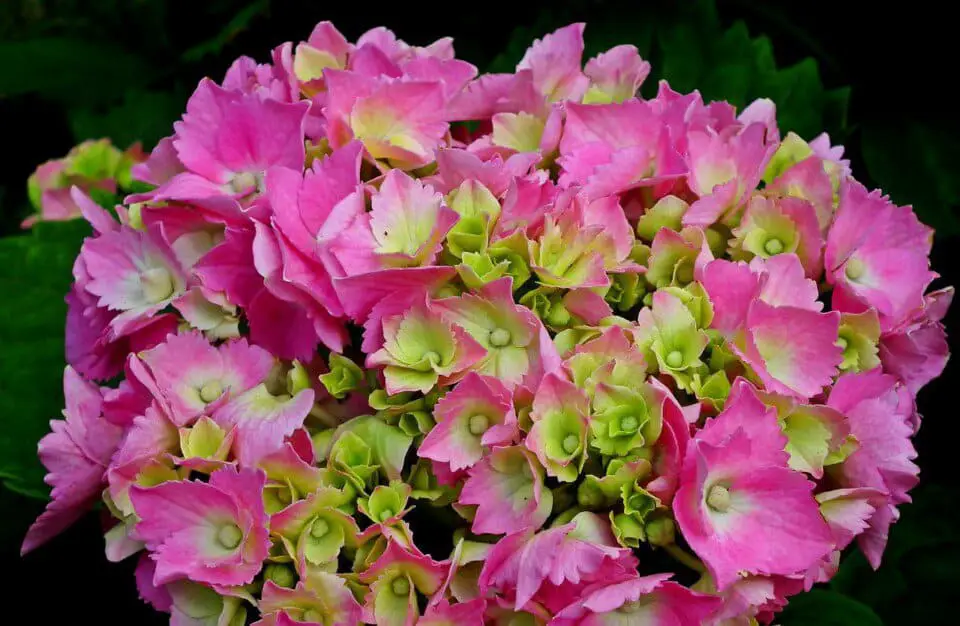Some links in the post are affiliate links and I get a commission from purchases made through some links found in the post.
If you are wondering how to grow hydrangeas from seeds, you have come to the right place.
Who doesn’t adore the calm, unassuming hydrangea that sits in the far corner of the yard and, without making a fuss, sends out waves of large blossoms throughout the summer?
These low-maintenance plants are ideal for novice gardeners as well as seasoned professionals. Try your hand at cultivating hydrangeas from their seeds if you are seeking a new gardening challenge.
To start growing hydrangeas from seeds you first need to collect them. After collecting them either sow immediately or put them in a cool spot till spring.
When planting, spread the seeds on top of the soil and then put the container in a sunny spot while keeping the soil moist. After 14 days the seeds should germinate and be ready to plant on.
It’s a lot of fun to start growing hydrangeas from seeds because the plants that emerge are completely original.
They are not identical copies of the plants that served as their parents, and it is impossible to predict how a seed will develop. Each hydrangea you cultivate from seed will be considered an entirely new cultivar.
How to Grow Hydrangea from Seed
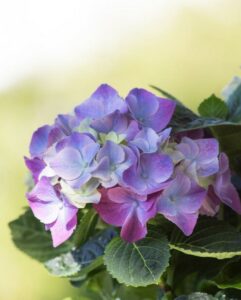 It would be best if you first collected the seeds to learn how to grow hydrangea from the seed. However, this can be done simultaneously by collecting the seeds of other plants.
It would be best if you first collected the seeds to learn how to grow hydrangea from the seed. However, this can be done simultaneously by collecting the seeds of other plants.
It is not as simple as you might believe it to be. Each hydrangea flower is composed of several smaller blossoms, some of which are showy but sterile and some much smaller but fertile.
The seeds are contained within the fertile blossoms themselves. First things first: you’ll need to gather those hydrangea seeds before you can start planting them. How to do it:
Just hold out until the blossom starts to wither and die. Keep an eye on it, and as soon as the blossom begins to wither, cover it with a paper bag.
The stem should be cut, and then the flower head should be allowed to finish drying within the bag. After a few days, give the bag a good shake to extract the seeds from the bloom.
Remove the seeds by carefully pouring them out. Note that they are quite little and can easily be confused for dust.
After you have collected the hydrangea seeds, you may immediately begin the sowing process. Another option is to put them away in a cool spot until spring, at which you can sow them.
In either scenario, scatter the seeds over the top of the potting soil.
Maintain an adequate moisture level in the soil, and shield the seeds from the wind and the cold. In most cases, the process takes around a week and a half.
Do Hydrangeas have Seeds?
These are the very small seeds a flowering plant produces, more commonly known as hydrangea. The normal methods for growing this plant include cloning, propagating, and planting seeds.
It takes roughly a week and a half for these seeds to germinate. The beginning of fall and spring are the two finest times to grow these seeds.
Red, white, blue, and pink are some of the colors that can be seen in the blossoms during the blooming season, which extends from early spring to late autumn.
Most hydrangea plants are either shrubs or trees that can grow up to three meters tall, as well as vines. “Hydrangea” comes from an ancient Greek word for “water vessel.”
This plant’s seed pods appear like water jugs, which is how the plant got its common name. Its spectacular flowers bloom at the very tip of the stem in a design that is very pleasing to the eye.
Additionally, its root and rhizome are utilized to produce homeopathic tinctures to treat conditions affecting the urinary tract.
On the other hand, due to cyanogenic glycosides, which can potentially be hazardous, they should not be consumed directly.
The most common question gardeners ask is, “can hydrangea plants be produced from seeds?” In a word, the answer is “yes,” they can.
Despite this, it may be a real pain because a significant amount of waiting and work is involved. However, the outcome will be fantastic because each new plant will be distinctive in its qualities and appearance.
On the other hand, the plant that develops as a result of cloning typically keeps the characteristics of the mother plant.
Additionally, a new plant is considered a cultivar whenever it originates from its seeds and thrives. After the seeds are produced, they require very little maintenance and can thrive in any soil.
Blooms of hydrangea plants are often the sites of seed production for the plant. These seeds are so minute that they may easily be confused for specks of dirt.
Because of this, one must exercise caution when working with them because they are susceptible to being blown away.
How do you get Seeds from Hydrangeas?
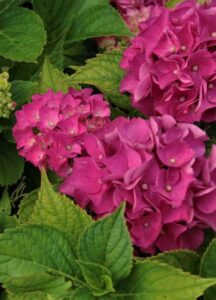 When hydrangeas are in full bloom, a certain mystique surrounds them.
When hydrangeas are in full bloom, a certain mystique surrounds them.
It should come as no surprise that they are frequently seen being planted in yards and gardens, given that they burst with stunning, brilliant flowers and bright, green foliage.
You can start shrubs from seed, despite the vast majority of home gardeners choosing to buy them from a plant nursery or to propagate them by taking cuttings from established bushes.
If you are up for the challenge, growing hydrangeas from seed can be a rewarding project. However, you must set aside time and think carefully about your actions.
Before you start, it is essential to know that most seeds will not produce offspring identical to their parents unless you harvest them from a specific plant.
Plant breeders have developed a large number of cultivars and hybrids over time. Some of these may not produce seeds that can be grown into a viable plant; even if they do, the offspring may look very different from the parent plant.
Hydrangeas do not produce single blooms but large inflorescences composed of tiny, inconspicuous fertile flowers and large, decorative infertile sepals.
These inflorescences are known as panicles. When it comes to huge mophead cultivars, the flouncy spherical blooms they produce might not contain many viable blossoms, if any.
What Time of Year Should you Plant your Hydrangea Seeds?
The ideal season to start a completely new hydrangea garden is right around the corner: The fall season is ideal for planting these flowering shrubs, which might surprise you.
Even if it might not blossom during this season, you can anticipate a large number of colorful blooms to appear in the late spring. “The temperatures are usually more favorable” for new hydrangea plants.
In addition, planting in the fall allows the plant to have time to build a root system before the ground freezes, which ensures that it will be in a position to provide a full season of color the following year.
How to Grow Hydrangea from Seeds
If you’re interested in growing hydrangea from seeds, you’re in the correct place.
There are dozens of different methods to create a stunning environment, but cultivating hydrangeas is surely one of the best. Various species of hydrangeas are in the landscape, but all have similar cultural requirements.
This plant will provide attractive and colorful interest throughout the summer and well into the fall if you grow it in either a shrub border, a mixed planting with other perennials, or even a single specimen planting.
Here is a guide to growing hydrangea from seeds so that you can have these stunning shrubs growing in your garden and enjoy them whenever your heart desires.
There are a few distinct strategies for cultivating hydrangeas.
You can start growing this plant by purchasing a starter transplant at your neighborhood nursery. However, this is arguably the easiest way to grow this plant because all the early work will have been done for you.
You need to put the shrub in the ground in your garden, give it some water, and watch it develop over time.
However, purchasing transplants can get quite pricey if you want to cultivate several different shrubs very quickly.
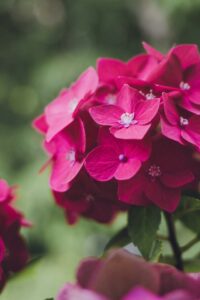 Because of this, many gardeners choose to propagate their plants, either by sowing seeds or cuttings from their existing plants.
Because of this, many gardeners choose to propagate their plants, either by sowing seeds or cuttings from their existing plants.
Growing hydrangeas from stem cuttings allow for faster plant development, but getting a plant to take root from a cutting is sometimes challenging.
Starting from seed takes more time, especially when you take into account the fact that some seeds can be quite small.
However, it is well worth the additional effort when you consider the amount of money you will save and the amount of variety you will be able to encourage in your garden.
Here are some tips to help you to grow hydrangeas from seeds successfully:
1. Collect Some Seeds
If you want to grow a plant from seed, you should collect the original parent seeds in the autumn. The best time to do this is when the seedpods have become dry and are just beginning to open.
The seeds will have a brown color and a consistency similar to dust.
Hydrangeas can produce seeds because of their enormous blossoms; nevertheless, the seeds are much smaller than the flowers.
After the flower has bloomed, you will need to wait up to a month and a half for it to wilt and dry out.
2. Put the Seeds Aside
At this point, you need to practice some patience to succeed! Until spring arrives, you won’t be able to accomplish anything useful with your seeds.
Please place them in a plastic bag before putting them in the cold storage compartment of your refrigerator.
3. Begin by Planting Your Seeds
You should plant the seeds of your hydrangeas around six to eight weeks before the last frost that is forecasted.
Scatter the seeds across the top of the wet, nutrient-rich potting soil. Avoid covering them with dirt in any way. To germinate, they require light.
4. Take Good Care of the Seeds
It may take up to four weeks for seedlings to appear, but while you wait for the seeds to germinate, you only need to sprinkle the soil regularly with a bit of warm water.
Maintain the container in an area that receives bright, indirect sunshine and watch for signs of growth.
5. Move the Shrubs to their new homes
You can move your seedlings outside if they have developed a minimum of two sets of true leaves and have reached the maturity stage.
Transplanting hydrangeas is best done in the spring or fall, depending on the size of the seedlings you are working with; however, if your seedlings are on the smaller side, planting in the spring is the better option.
Because of this, the risk of dying during the winter may be reduced.
How Long Does it Take to Grow Hydrangeas from Seeds
You can start germinating the seeds after you have harvested them; however, this will leave you with the responsibility of taking care of hydrangea plantlets during the fall and winter seasons, during which it may be difficult to keep them alive.
It should take the seeds around a week and a half to germinate. However, it is important to keep the soil moist but not drenched with water.
It would help if you continue caring for the plantlets as you would typically for hydrangea cuttings. Once they reach their size, they may be transplanted into their pots.
Moreover, this includes providing them with an appropriate amount of light (ideally dappled light or semi-shade), watering them consistently to prevent them from drying out, and planting them in potting soil with good drainage.
It takes about a year and a half for hydrangeas to mature into a sufficiently established plant after growing from seed. After 14 months, you can plant the hydrangea directly into the ground.
Final Thoughts
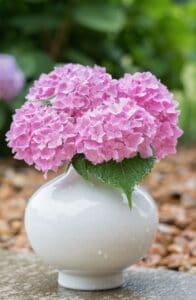 If you have the good fortune to already have a gorgeous Hydrangea in your garden, you will most likely want to acquire a few more of these shrubs so that you can plant them in different parts of your property.
If you have the good fortune to already have a gorgeous Hydrangea in your garden, you will most likely want to acquire a few more of these shrubs so that you can plant them in different parts of your property.
These flowering shrubs can be easily propagated from cuttings, but if you are more of a do-it-yourselfer.
The vast majority of hydrangeas may be propagated from seed. You can get seeds from dried-out blooms or buy them, but remember that not all hydrangea varieties generate viable seeds.
The procedure takes a long time, but watching your seedlings germinate and flourish can be wonderful after much patience and hard work.

